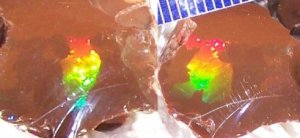OpalLoverCH
Rough_Rock
- Joined
- Jan 9, 2008
- Messages
- 8
Hello everybody
Does someone know something about the formation/genesis of Ethiopian opals ?
I mean the ones which have brown body color (and sometimes incredible play of color). The name is also opalised `thunder eggs`, I think.
I`m nearly sure that this kind isn`t sedimented and I think it looks like obsidian (volcanic glass) or something like that. I have heard that obsidian could contain to 70% silica or more. But how does the silica spheres form and assemble in the (viscous) obsidian (glass), if it is obsidian ?
Or is it originally suspended in water and does the water evaporate later ?
Could one say that the opalished thundereggs are more like `opal glass` than real opal ?
Could it be that it is a lattice of ordered crystals (cubic, hexagonal, spheres or something else) but not amorphous silica spheres ? Are thunder eggs `bullets` of the volcano or bubbles ? Ejected from the volcano ? Or injected into volcanic ash ? Who does know ?
Who can help ? I am very interested in opals and there is not much to read about this special variety. Please give me input, it would be great...
Thank you so much and by,
OpalLover

Does someone know something about the formation/genesis of Ethiopian opals ?
I mean the ones which have brown body color (and sometimes incredible play of color). The name is also opalised `thunder eggs`, I think.
I`m nearly sure that this kind isn`t sedimented and I think it looks like obsidian (volcanic glass) or something like that. I have heard that obsidian could contain to 70% silica or more. But how does the silica spheres form and assemble in the (viscous) obsidian (glass), if it is obsidian ?
Or is it originally suspended in water and does the water evaporate later ?
Could one say that the opalished thundereggs are more like `opal glass` than real opal ?
Could it be that it is a lattice of ordered crystals (cubic, hexagonal, spheres or something else) but not amorphous silica spheres ? Are thunder eggs `bullets` of the volcano or bubbles ? Ejected from the volcano ? Or injected into volcanic ash ? Who does know ?
Who can help ? I am very interested in opals and there is not much to read about this special variety. Please give me input, it would be great...
Thank you so much and by,
OpalLover










300x240.png)